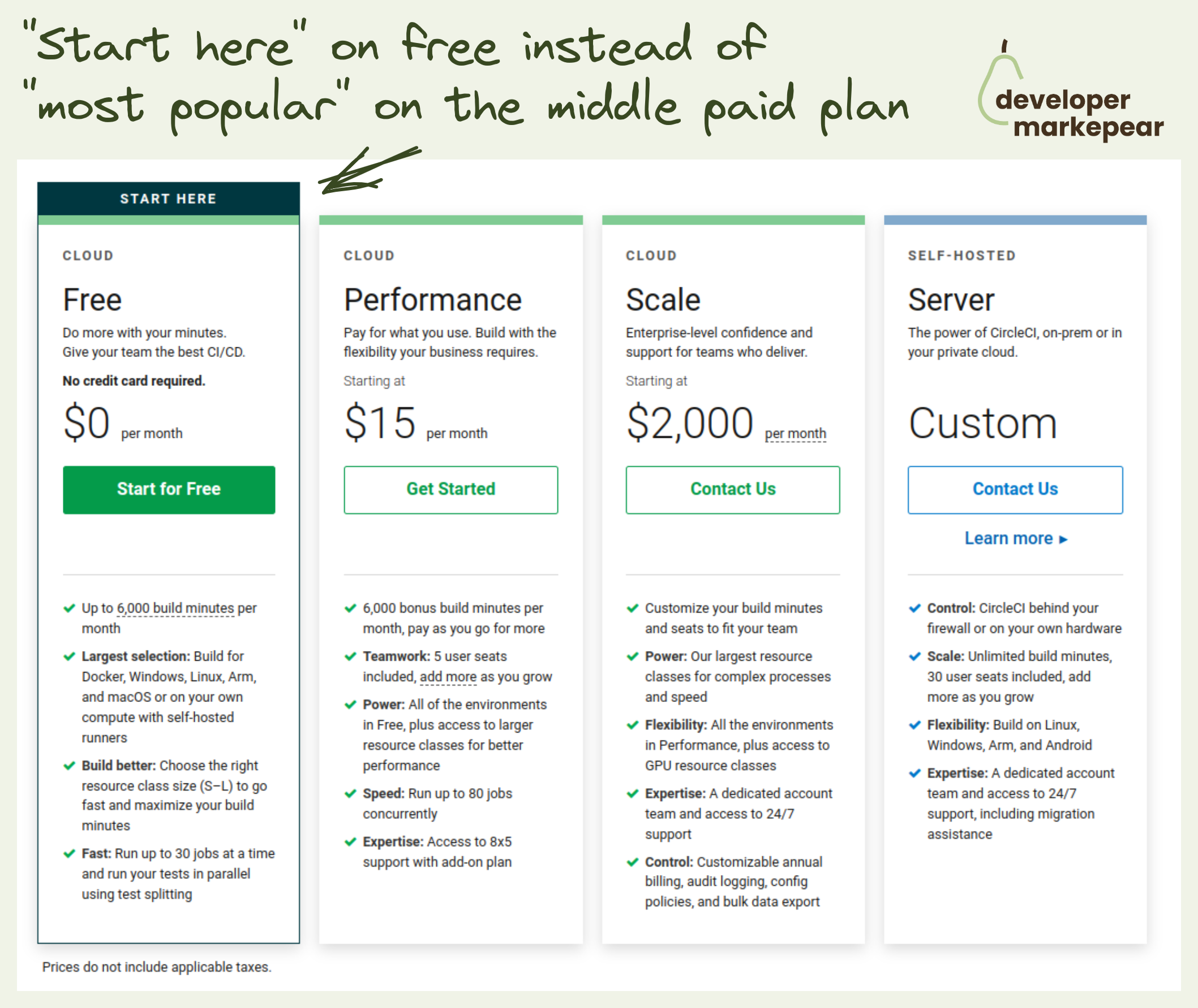
Why not highlight your free plan?
Most companies highlight their middle paid plan saying it is "most popular".
First thing, yeah, sure it is your most popular plan.
But more importantly, most visitors will not convert to your paid plans right away.
So why not try and capture as many devs as possible on the free plan?
If they like your dev tool there are many things you can do to convert some of them to paid plans.
But if they leave that pricing page and go with some other free tool, you are not converting anyone.
@CircleCI highlights free and they are in the mature, competitive market of CI CD tools.
Idk, it really does make a lot of sense to me.
If people need more advanced features they will choose higher plans anyway.
But if they want to get things started with the basic plans they will choose free or go elsewhere.
I'd rather have them choose free than none.

What CTAs should you choose for your open-source project homepage?
Was always wondering what is my default.
There are many options: "See docs", "Get started", "Sign up", "Start X"
But in open-source you want people to start playing with it, install it.
So what should you choose?
Recently came across Astro homepage and loved what they chose.
"Get started"
Install code
Whatever I choose I will actually get my hands dirty.
I think this will be my default from now on.
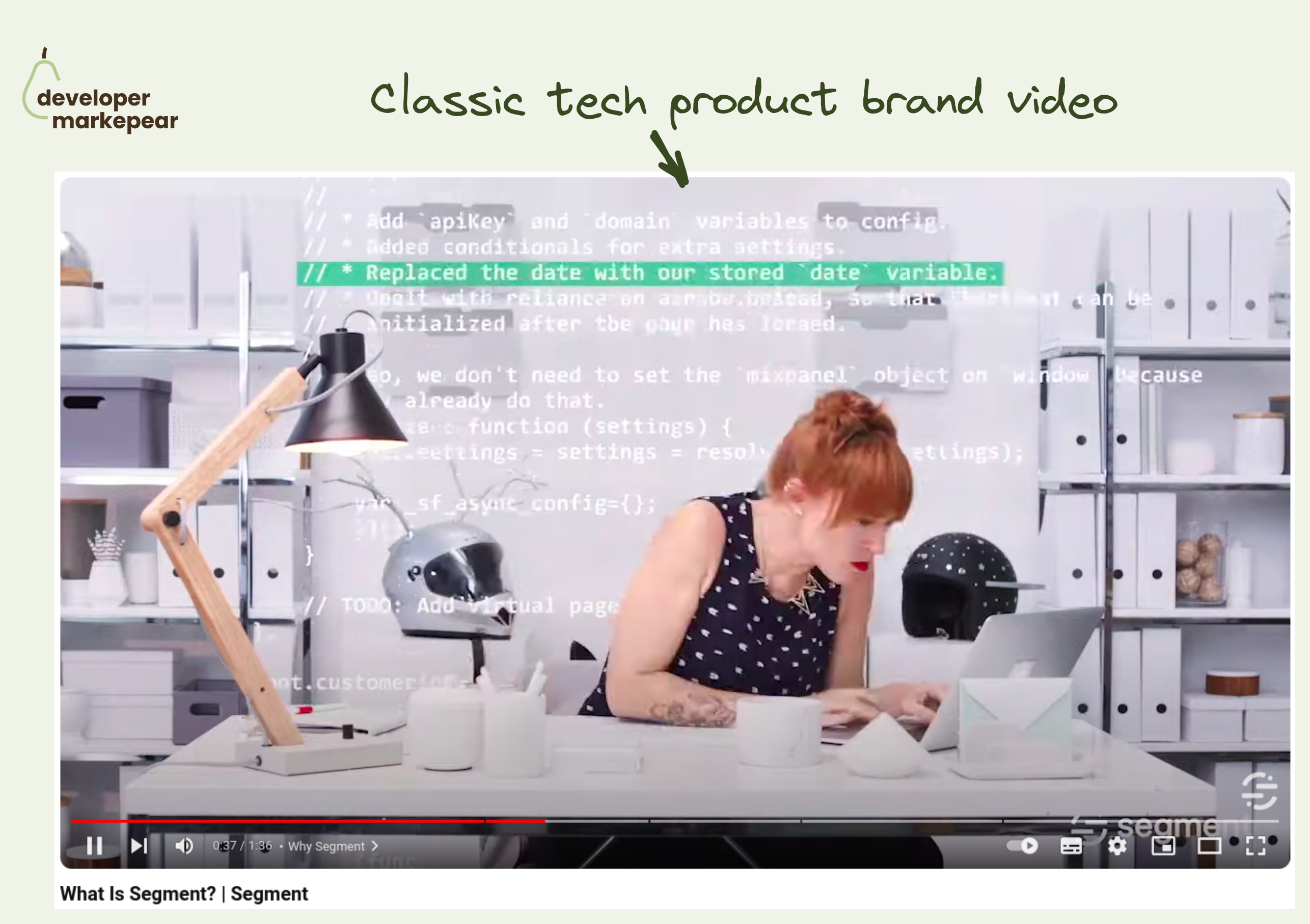
Came across this classic What is Segment brand video while watching an interview with one of the folks behind it, Maya Spivak (she is awesome btw).
What I like about it is that:
• it is fun, not formal, builds rapport
• it introduces the core problem the tool solves
• it shows the tech and explains it in a way that is simple but not simplistic
And it follows a flavor of the classic AIDA format:
Putting all that in 90 seconds is hard.
And even though this video is 4 years old it could easily still work today IMHO.
Really solid baseline to s̶t̶e̶a̶l̶ get inspired by ;)

The homepage header is about landing your core product message.
For Modal it is basically LLM infrastructure with great developer experience.
And they do a great job delivering it:
Top job on that header folks!

Need one more call to action idea for your dev tool blog?
How about starting an article with it?
Sounds weird but if done right it can work. Even with devs (or maybe especially with devs).
Earthly did and they are known for great dev-focused content.
Ok, so how does it work?
You start your article with a contextual call to action where you explain:
And then you let people read.
Those who find the topic important will remember you and/or maybe click out to see more.
I like it. It's explicit, transparent, and actually noninvasive.

Devs are builders.
Make your home page for builders.
Go directly into the "how" instead of the way.
Many devs when they land on your home page, already know the "why".
I love that it:
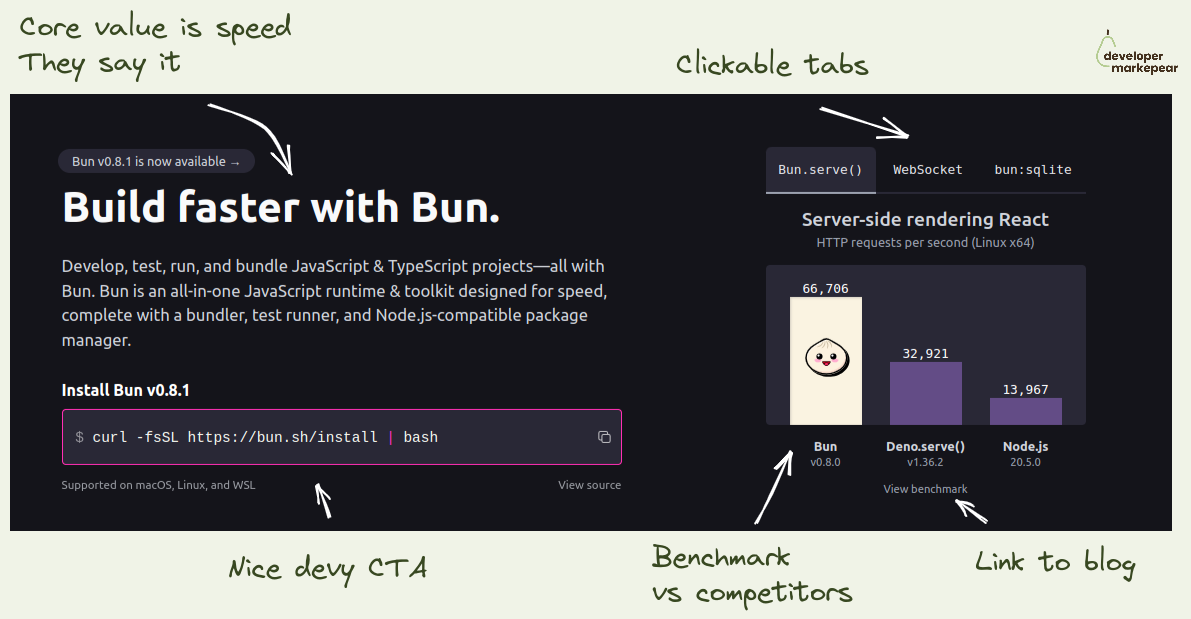
If your dev tool's USP is that it is faster -> Show it in the header
I like how folks from Bun focus on the fact that they are a faster library.
They show the benchmark as the key visual on the homepage header.
I love it.
If you think about it how else do you really want to show that you are faster?
This is believable, especially with a link to the benchmark so that I can dig deeper.
They show competitors, they don't pretend they don't exist.
And they talk about being faster left right and center.
I mean, they drive this "we are faster" home for me.
If that was important to me, I'd check it out.

One of the top-performing conversion flows in dev-focused articles.
"Aside CTA" in the "How to do {jobs to be done}" article.
You know the drill:
And Export SDK executes it (almost) perfectly:
One thing that could be tested and changed is putting this "Aside CTA" mid-article and not at the end (tip from Martin Gontovnikas).
A good thing to try if you are running the "How to do {jbtd}" article strategy.

Beautiful growth loop that uses GitHub PRs to spread awareness even internally in the org.
And just one dev needs to sign up for the product to start it.
Works like this:
Heard about it on Lenny's podcast episode with Ben Williams (the story starts at 20:53)
... and then signed up to see the actual PR.
I really love this one as it allows you to spread inside the organization even if everything is on-prem and you never get to see it.
Those PRs are just working behind the scenes doing marketing for you.
Brilliant!

How to write a "What is {MY CORE KEYWORD}" article that gets to the top of HackerNews? 👇
First of all, almost no one succeeds at that as you write those articles for SEO distribution, not HN distribution.
To get an SEO-first article on HN your content quality bar needs to be super high.
But you can do it.
PlanetScale managed to get their "What is database sharding and how does it work?" on the orange page (kudos to Justin Gage!).
Here is what was interesting about that article:
𝗦𝘂𝗽𝗲𝗿 𝘁𝗼 𝘁𝗵𝗲 𝗽𝗼𝗶𝗻𝘁 𝗶𝗻𝘁𝗿𝗼.
• ❌ No "In today's fast-paced data-driven world enterprises work with data" stuff.
• ✅ Just "Learn what database sharding is, how sharding works, and some common sharding frameworks and tools."
𝗛𝗶𝘁𝘁𝗶𝗻𝗴 𝗸𝗲𝘆𝘄𝗼𝗿𝗱𝘀 𝘄𝗵𝗶𝗹𝗲 𝗯𝘂𝗶𝗹𝗱𝗶𝗻𝗴 𝗿𝗮𝗽𝗽𝗼𝗿𝘁 𝘄𝗶𝘁𝗵 𝘁𝗵𝗲 𝗱𝗲𝘃 𝗿𝗲𝗮𝗱𝗲𝗿.
💚 Speaking peer to peer, not authority-student:
• "You’ve probably seen this table before, about how scaling out helps you take this users table, all stored on a single server:"
• "And turn it into this users table, stored across 2 (or 1,000) servers:"
• "But that’s only one type of sharding (row level, or horizontal). "
𝗨𝘀𝗶𝗻𝗴 𝗷𝗮𝗿𝗴𝗼𝗻 𝗮𝗻𝗱 𝘂𝗻𝗱𝗲𝗿𝘀𝘁𝗮𝗻𝗱𝗶𝗻𝗴 𝘆𝗼𝘂𝗿 𝗮𝘂𝗱𝗶𝗲𝗻𝗰𝗲
Things like:
• "Partitioning has existed – especially in OLAP setups"
• "Sifting through HDFS partitions to find the missing snapshot "
𝗔𝗰𝘁𝘂𝗮𝗹𝗹𝘆 𝗲𝘅𝗽𝗹𝗮𝗶𝗻𝗶𝗻𝗴 𝘁𝗲𝗰𝗵𝗻𝗶𝗰𝗮𝗹𝗹𝘆 𝗵𝗼𝘄 𝘁𝗵𝗶𝗻𝗴𝘀 𝘄𝗼𝗿𝗸
🔥 Look at the section "How database sharding works under the hood" with subsections:
• Sharding schemes and algorithms
• Deciding on what servers to use
• Routing your sharded queries to the right databases
• Planning and executing your migration to a sharded solution
🎁 𝗕𝗼𝗻𝘂𝘀: 𝗽𝗹𝘂𝗴 𝗶𝗻 𝘆𝗼𝘂𝗿 𝗽𝗿𝗼𝗱𝘂𝗰𝘁 𝗴𝗲𝗻𝘁𝗹𝘆
Section "Sharding frameworks and tools" shares open-source tools (every dev, but HN devs in particular like OS projects).
And there as an info box, you have the info that Planetscale comes with one of those OS projects deployed.
Just a beautifully executed piece of content marketing.
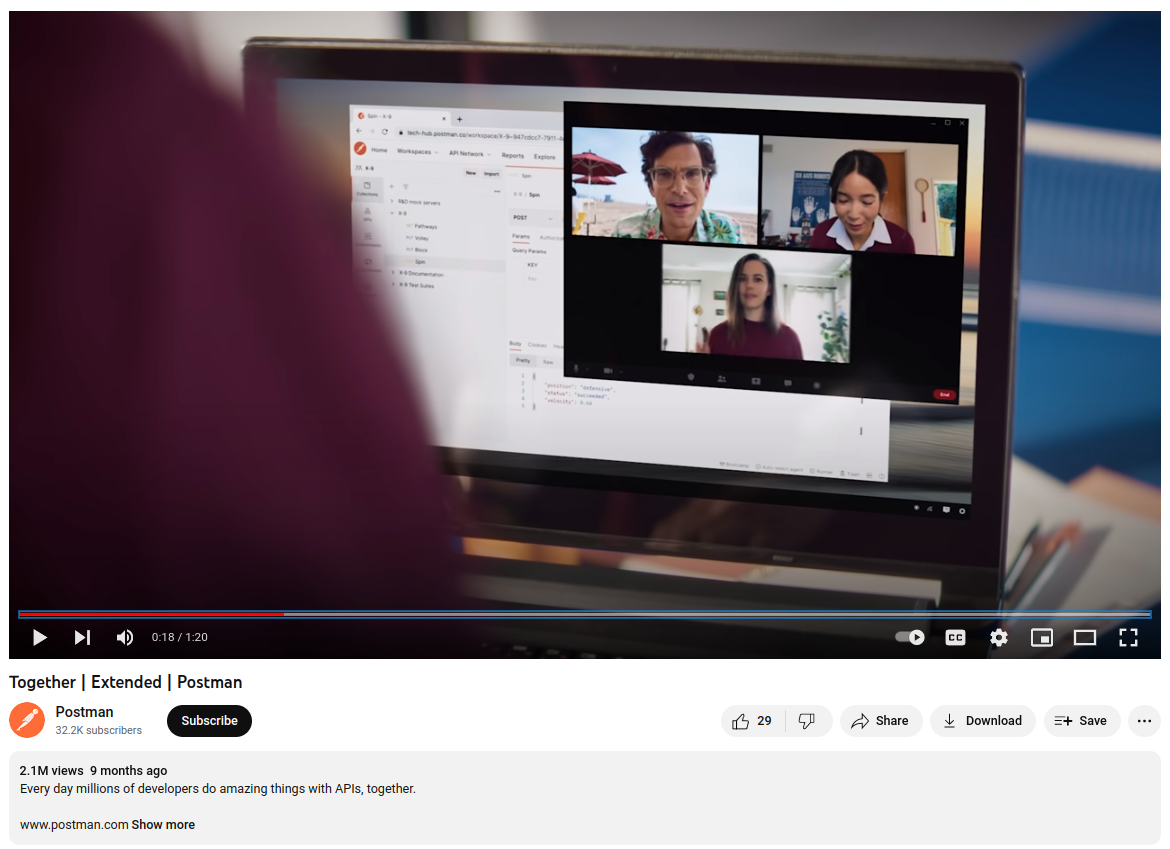
How to do a dev-focused brand video and get 10M+ views?
Making a memorable brand video is hard.
Doing that for a boring tech product is harder.
Doing that to the developer audience is next level.
Postman managed to create not one but three of those brand videos that got from 4M to 10M youtube views.
The videos I am talking about are:
So what did they do right?
Honestly, I am not exactly sure what special sauce they added but those are just great videos that you watch.
And I definitely remember them and the company which is exactly what you want to achieve with brand ads.

An interesting option to push people to read the next article.
You use a slide-in triggered on a 75% scroll with a "read next" CTA in the bottom left.
On the aggressive side for sure but when the article you propose is clearly technical it could work.
And if your articles are not connected to the product explicitly you do need some ways to keep people reading and see more of your brand.

"There are two types of companies": Just a beautiful piece of copy from Fly.io
Doing us vs them doesn't always play out well.
But folks from Fly made it snarky and playful and fun.
And they basically said that they are:
And this is just such a nice brand play as well.
You just show personality and confidence in this devy snarky way.
I dig it.
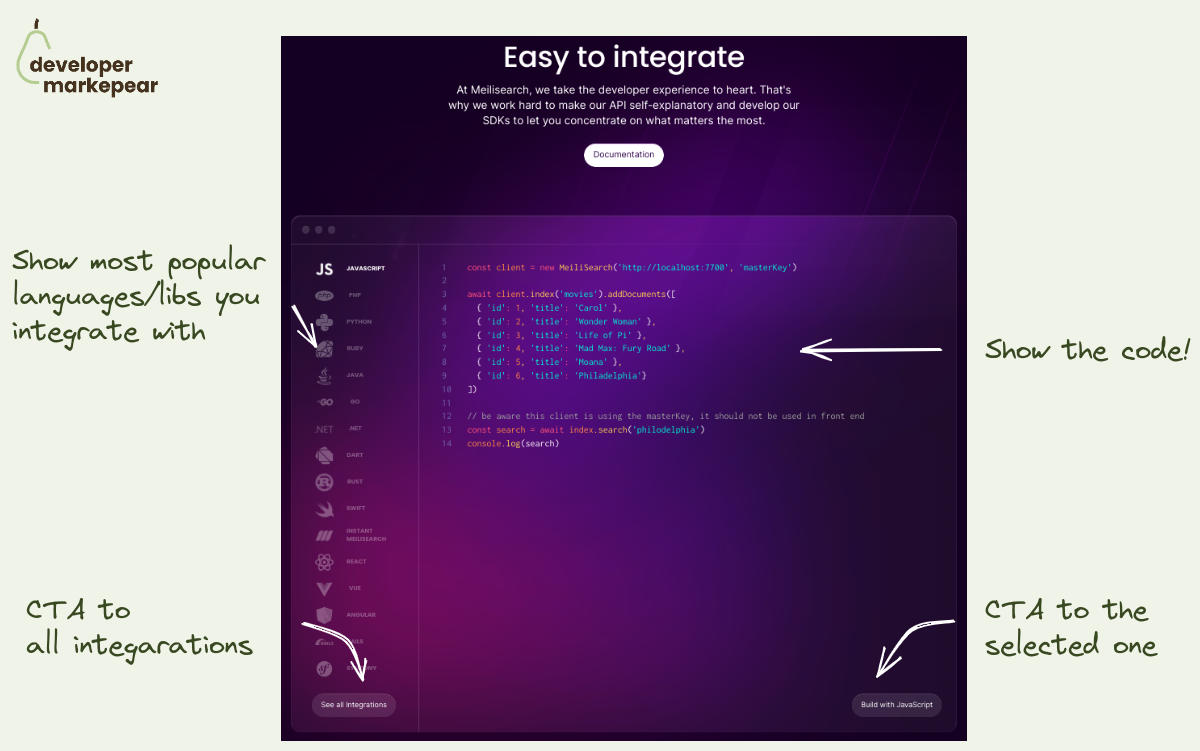
How to show integrations on your dev tool homepage?
Every dev tool needs to integrate with other libraries in the space.
And you want to show how well integrated with the ecosystem you are.
But you ctually want to do a bit more than that.
You want devs to see how easy / flexible / clean it would be for them to use it.
That is why instead of showing just logos from your ecosystem it is good to show the code too.
Meilisearch does that beautifully:
I am sure this is getting more clicks than just a list of logos.

I like that this is both strong and subtle.
It comes right after I've delivered a smell of value with a technical intro.
And I can see that there is more value to come after thanks to the table of contents.
The CTA itself feels like an info box in the docs rather than a typical subscribe CTA.
Good stuff.
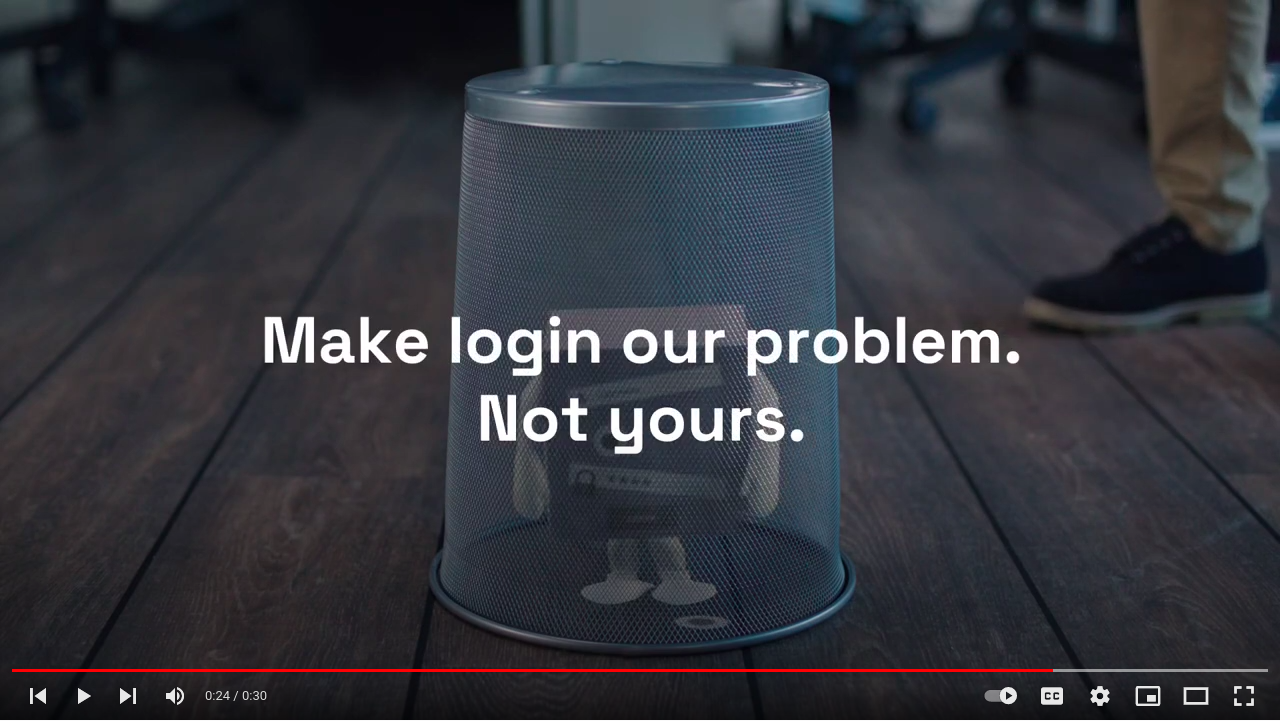
Make login our problem. Not yours.
This is a beautiful messaging of Auth0 solution.
Login
Simple explanation of what it does/gives you.
Simplified of course
Our problem. Not yours.
You "outsource" this boring but important problem to someone else.
It also has a feel of SaaS in there.
They will take care of it.

How to present many features at once?
Sometimes your dev tool has many features/products that you want to show.
❌ Showing all of them as separate sections doesn't work with more than 3. It just gets too long very quickly.
✅ You can go with the tabs pattern where each tab has copy+visual for a feature.
💡 But there is another option that makes a ton of sense when you have many features to show.
Interactive tiles of different sizes.
💚 I like the implementation of that pattern coming from Clerk:
That pattern can work really well on blogs or learning centers too but I think we're going to see more of it on dev tool websites.
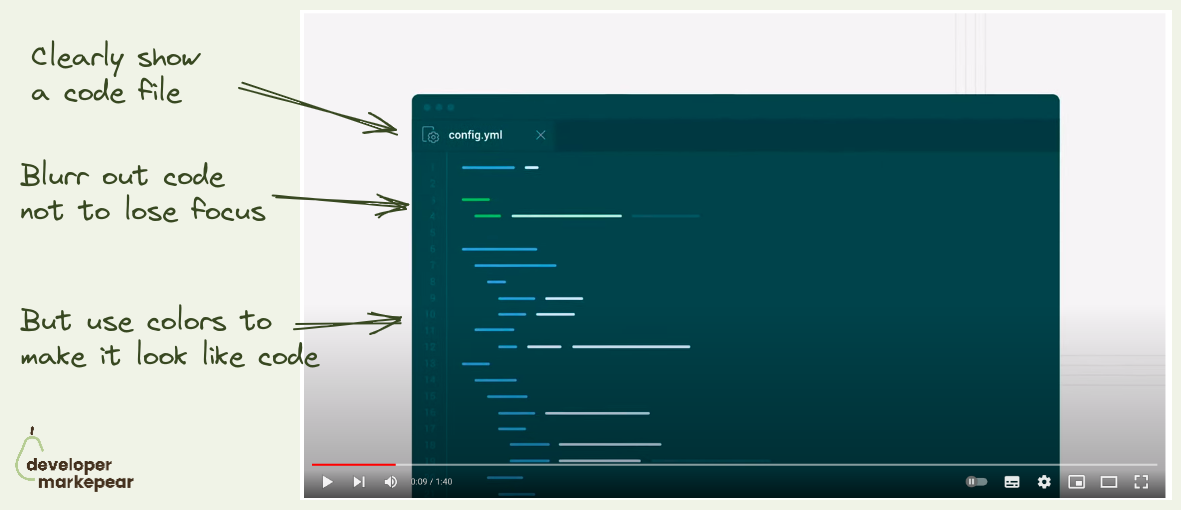
Showing code and UI in an explainer video is always a dance and rarely ends well.
You want to show the code to make it devy.
But you don't want to show everything not to overwhelm.
The same goes for UI which should look like your UI.
But show only what is necessary.
It's a struggle but CircleCI does it really nicely in this explainer:
They do the same for the UI later in the video.Just a really clean way of explaining things. Nice!

𝗛𝗼𝘄 𝘁𝗼 𝗰𝗿𝗲𝗮𝘁𝗲 𝗴𝗼𝗼𝗱 𝘁𝗲𝗰𝗵𝗻𝗶𝗰𝗮𝗹 𝗰𝗼𝗻𝘁𝗲𝗻𝘁 𝘁𝗵𝗮𝘁 𝘁𝗵𝗲 𝗛𝗮𝗰𝗸𝗲𝗿 𝗡𝗲𝘄𝘀 𝗮𝘂𝗱𝗶𝗲𝗻𝗰𝗲 𝗹𝗶𝗸𝗲𝘀?
The general tip is simple. Create content that the HN audience finds interesting.
𝗧𝗵𝗮𝘁 𝘁𝘆𝗽𝗶𝗰𝗮𝗹𝗹𝘆 𝗺𝗲𝗮𝗻𝘀:
But how do you actually do that?
𝗢𝗻𝗲 𝗼𝗳 𝘁𝗵𝗲 𝗽𝗹𝗮𝘆𝗯𝗼𝗼𝗸𝘀 𝘁𝗵𝗮𝘁 𝘀𝗼𝗺𝗲 𝘁𝗲𝗰𝗵𝗻𝗶𝗰𝗮𝗹 𝗳𝗼𝘂𝗻𝗱𝗲𝗿𝘀 𝗱𝗲𝗽𝗹𝗼𝘆𝗲𝗱 𝘄𝗮𝘀 𝘁𝗵𝗶𝘀:
That was exactly what folks from CockroachDB did at the beginning. Heard about it on one of the episodes of the Unusual Ventures podcast with Peter Mattis from Cockroach Labs.
𝗘𝘅𝗮𝗺𝗽𝗹𝗲𝘀 𝘁𝗵𝗮𝘁 𝗵𝗶𝘁 𝘁𝗵𝗲 𝘁𝗼𝗽 𝗼𝗳 𝗛𝗡:
• "CockroachDB Stability Post-Mortem: From 1 Node to 100 Nodes"
• "Serializable, lockless, distributed: Isolation in CockroachDB"
• "How CockroachDB Does Distributed, Atomic Transactions"
Kudos Cockroach Labs team and thanks for sharing!

Algolia gets over 80% of referral traffic from a single free tool they created called Search Hacker News.
But why does it work so well for them?
Hacker News doesn't really have a native search experience.
Algolia gives devs an amazing search experience out of the box.
So folks from Algolia created their own website where you can search Hackernews... with Algolia search engine.
Of course, when you click on "Search by Algolia" you get directed to the website and can learn how to set up a similar search, which you have just used yourself.
What I love about this:
And looking at the results it delivers.

Digital Ocean went for an ad for the Hactoberfest in a tricky place.
To keep it in the medium that fits YouTube shorts they:
I think doing YouTube shorts is an interesting opportunity in a yet unsaturated market (as of 2022).
And doing ads that fit that medium so nicely is an art.
Good job DO!

How easy it is to get started is a big conversion factor for any dev tool.
Devs want to test things out and if it is hard to do they will be gone testing a competitor that made it easy.
And so a good how-to section on your homepage can make a big difference in getting devs to that first experience.
Appsmith does it beautifully with their 1-2-3 How-to section:
It is so engaging and just beautifully designed. And the CTA to additional resources like integrations, widget library, and docs make the message land. I do believe it is easy to set this up.
Great pattern to copy-paste imho.

Thinking about your next conference giveaway idea?
How about a coconut? Datafold did just that!
Coconut + logo burned on it + a person who can open them up
=
A memorable, shareable, fresh (literally), and wholesome conference experience.
And I bet it didn't cost an arm and a leg too.
It goes to show how creativity matters when planning those things.
Thinking about doing a similar thing in Poland... with potatoes of course ;)
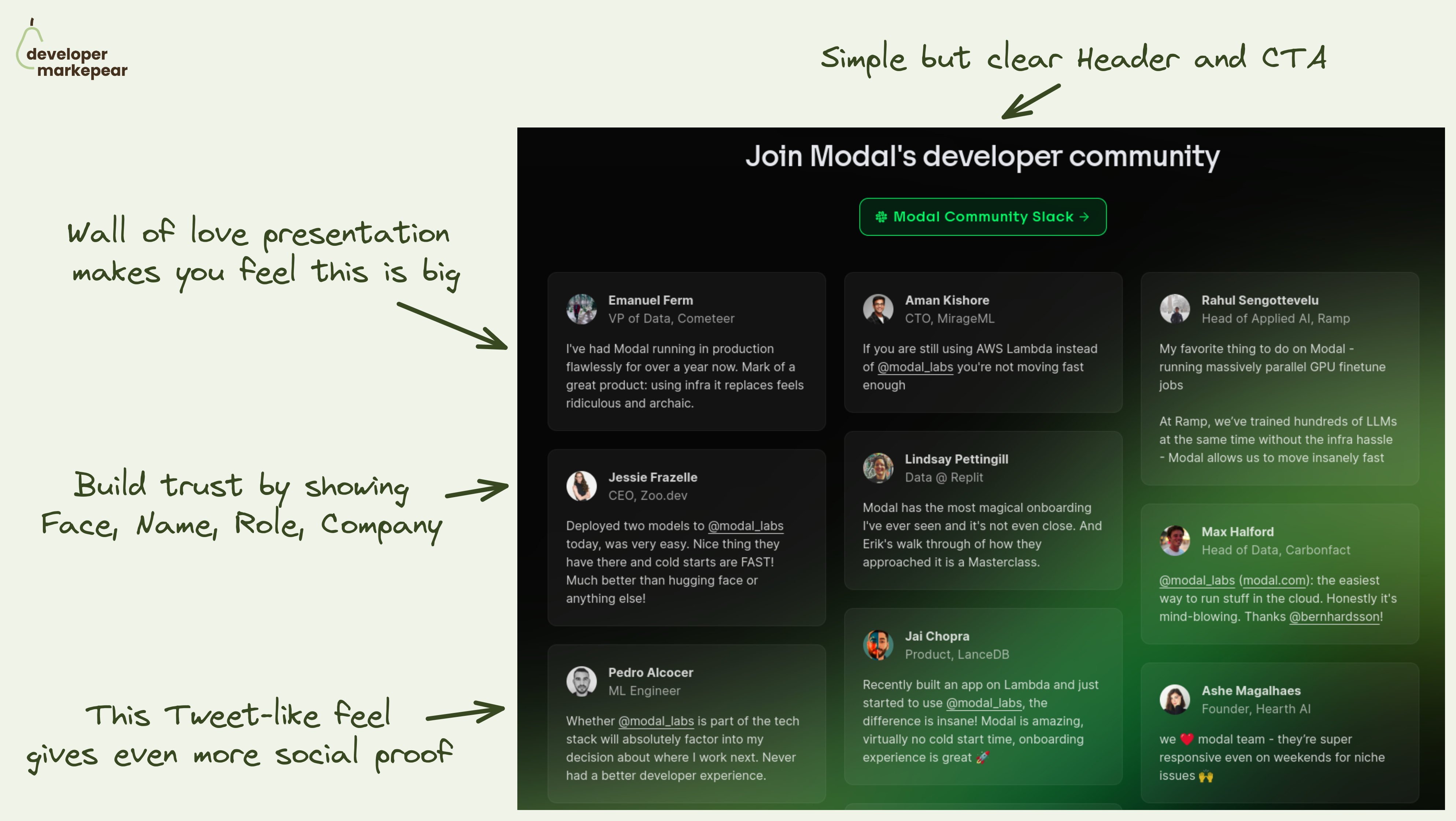
The main message you want to land on your homepage community section is:
"We have a big community of devs who love using the product"
🚧 That helps you tackle obstacles your dev reader has:
💚 Modal solves it beautifully by going simple but smart:
It lands the message that this section should land for sure. I really like it.
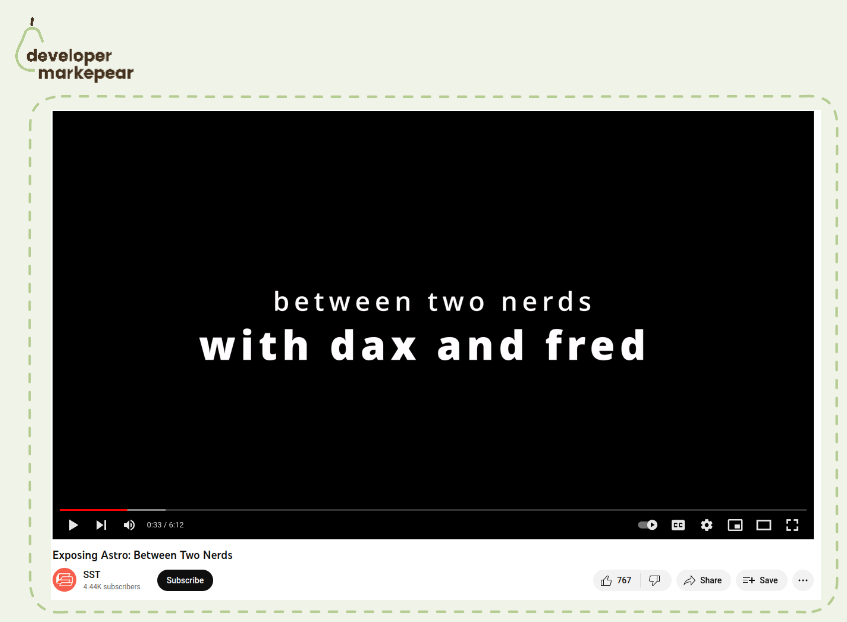
This is one of the most interesting content pieces I have seen in dev tools recently 👇
Comes from @SST and believe it or not is a comedy video created to promote integrations.
That's right.
So SST integrated with Astro and instead of creating "just another how-to use X+Y" video they created this:
It was a fun brand play but got way more views than a tutorial ever could.
And it connected with their audience in a human way that will be remembered (and shared).
Nice.

OK, the best way of getting GitHub stars is by creating a project that solves real developer problems well.
I assume you have done that already and the metric that people love to hate ⭐ is growing organically.
What do you do now?
I mean you got to ask people in one way or another.
Many companies put it in their navbars or hello bars.
Posthog adds a sticky banner at the bottom of the page that follows you as you scroll.
It also shows a start count which at their size (11k + stars) acts as social proof.
You can close it and the next time you visit the page it will be off not to push too much.
I like the concept makes sense to test it out this way imho.

Awesome sponsorship ad from Trieve in the Cassidy Williams newsletter.
Not sure who wrote it but it must have been a dev ;) It is just so refreshingly to the point.
💚 What I like:
This ad does it so gracefully and quickly it is just hard not to love.
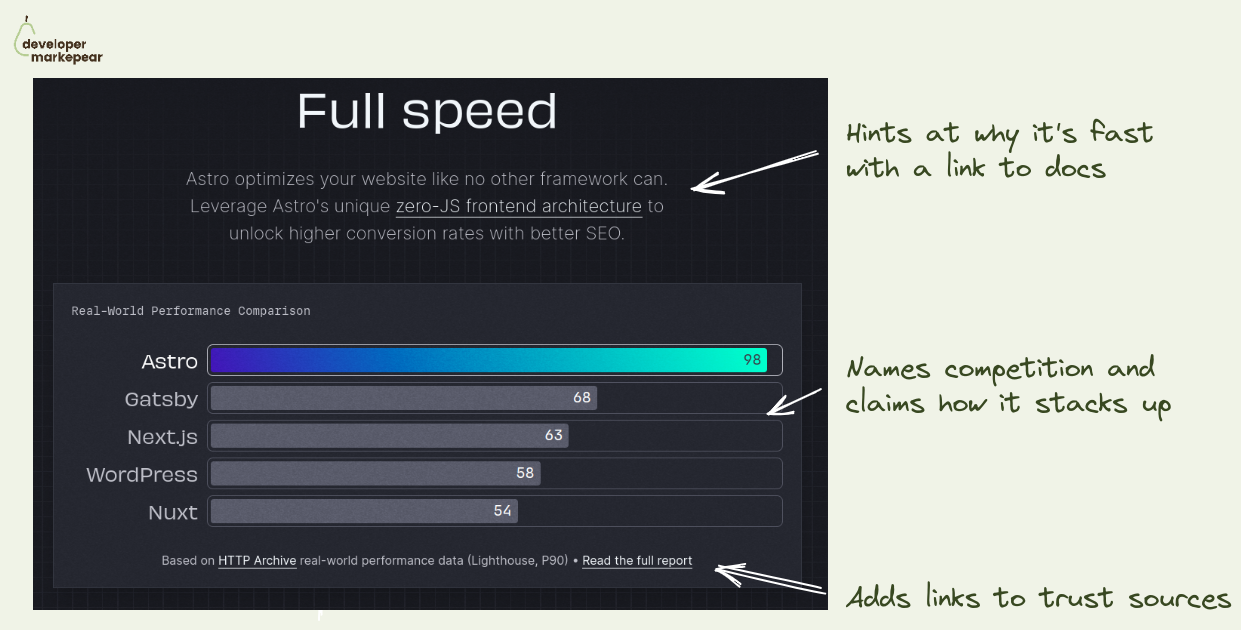
Your dev tool is faster/more scalable/more X -> show it with benchmarks.
For some tools the entire unique selling point is that they are faster.
You build your messaging around that, put a flavor of "fastest Y for X" in the header and call it a day.
But devs who come to your website cannot just take your word for it. They need to see it, test it.
For some tools it is possible to just see it for themselves, get started.
But you cannot expect devs to really take a database or an observability platform for a spin.
As to test the speed or scalability on realistic use case you need to...
... set up a realistic use case. Which takes a lot of time.
But you can set that use case and test it for them. With benchmarks.
I really like how Astro approached it:
If your usp is that you are faster/more scalable/ more whatever. Back it up. This is the nr 1 thing devs on your website need to trust you with to move forward.

I love this dev tool header copy from Neon.
❌ They could have gone with "We make your data fly" or "10x your database developer efficiency" or other stuff like that.
💚 Instead, they spoke in a clear dev-to-dev language:
Simple, clear, and to the point. No fluffs given. Love that.
"But we are selling to the boss of a boss of that developer user persona"
Then let that dev champion understand what you are doing and bring it to their boss.
"But we are going pure top-down"
Then does that boss of a boss of a boss actually evaluate your infra tool themselves or send their architect?
Maybe 90% of your site traffic is the buyer-persona CTO. But my bet is, it isn't even 1%.
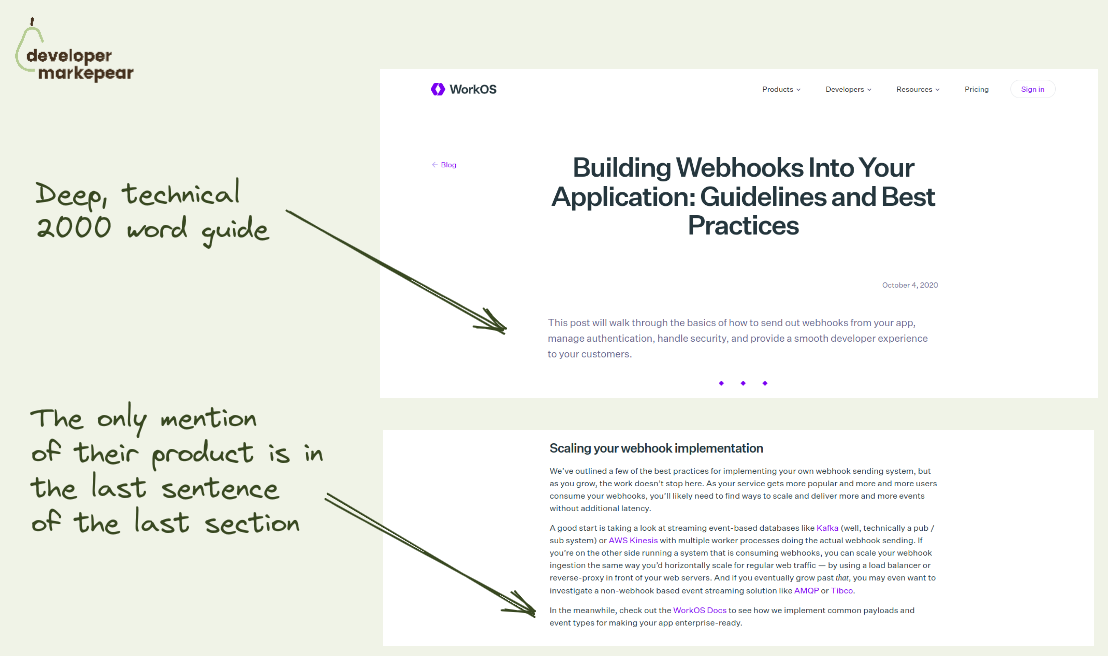
This is how you write dev tool JTBD blog posts.
Masterclass of writing this type of content from @WorkOS imho.
Deep 2000 word guide that explains how to add webhooks the your application.
Goes into examples, best practices, everything.
One thing it doesn't do?
It doesn't push the product left right and center.
In fact, the only CTA is hidden in the very last sentence of the very last section.
Why?
Because most likely, the reader's intent is around understanding the problem at this point.
They want to understand what adding webhooks to their app really means from the practitioner's standpoint.
And they did that beautifully.
Could you have pushed the product a bit more? Sure.
But by answering the actual questions devs came here for they managed to build trust.
And I am sure got their fair share of click-throughs and signups anyway.

How to run developer-focused Reddit ads that get upvoted?
Reddit is well known for anti-promotional sentiments.
Just post something along the lines "you can solve that with our dev tool" and see.
So running ads on Reddit feels even more like a no-no.
Especially if you add problems with bot clicks and attribution as most devs will have some sort of blocks.
But you know your audience is on Reddit.
And for some of us, it may very well be the only social platform they are on.
So what do you do?
This is how @Featureform approached it to get almost 100 upvotes on an ad:
If you are going for brand awareness rather than a direct conversion those types of ads can work very well.
I liked it for sure.

Pushing cold blog readers to try your tool rarely works.
So you need a transitional CTA, something that worms them up.
But it needs to be aligned with the goals of the reader.
And I think pushing folks to a community discord is a solid option.
I like the copy "Discuss this blog on Discord" as it is very reader-focused.
Some folks read the article and have more questions.
They want to discuss it somewhere.
And while you could just do a comments section, a community gives you more options to get people closer to the product.

Many dev tools have complex pricing and packaging.
Say your dev tool/platform has many product offerings.
And you offer usage-based pricing but also enterprise plans but also per-product options, and additional customizations.
But you want to present it in a way that is manageable for the developer reading your pricing page.
Mux solves it this way:
Extended headers on pricing pages are not common as they add friction.
But sometimes adding friction is exactly what you need to do.
Mux managed to make this page (and their offering) easy to navigate by adding a little bit of friction at the beginning.
Maybe you don't browse plans right away but at least you don't waste energy (and attention) on the parts of the page that doesn't matter to you.
Good stuff.

A great example of a quote-style ad.
I like it because:
Great stuff.
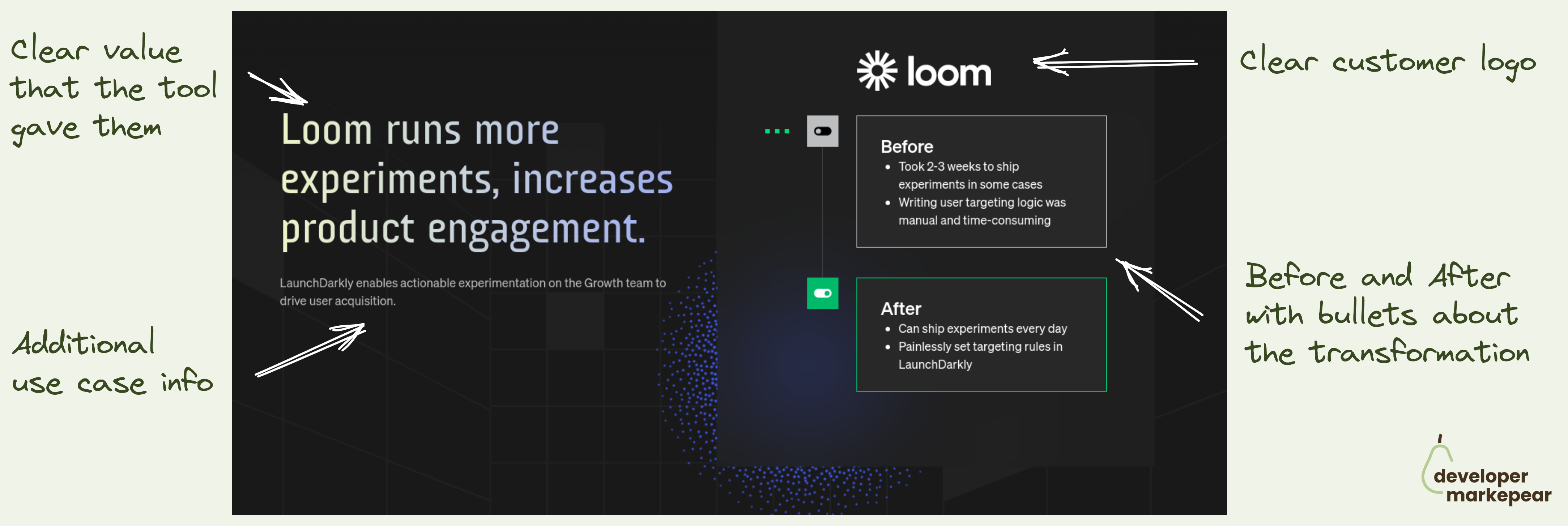
Looking for a good dev-focused case study format?
People tell you to follow a classic Hero > Problem > Solution > Results.
They tell you to show numbers, talk value, etc.
And it is true. Great format.
But packaging this for devs is hard.
For example, putting numbers in there, and framing it in a "save 28min every week" is a recipe for losing trust with that dev reader.
That is if you can even get those numbers from your customers.
I like how @LaunchDarkly solves it.
Hero section:
Case study body:
They keep the content down to earth and devy but still frame it in a value-focused way.
I like that that they speak in the currency that devs care about.
Wasted time.
Before: "Took 2-3 weeks to ship"
After: "Can ship experiments every day"
The cool thing is you could actually use this hero section format and then have a more technical user story below. By doing that you could speak to the why and how.
That depends on your target reader for this page of course.
Anyhow, I do like this format and I am planning to take it for a spin.
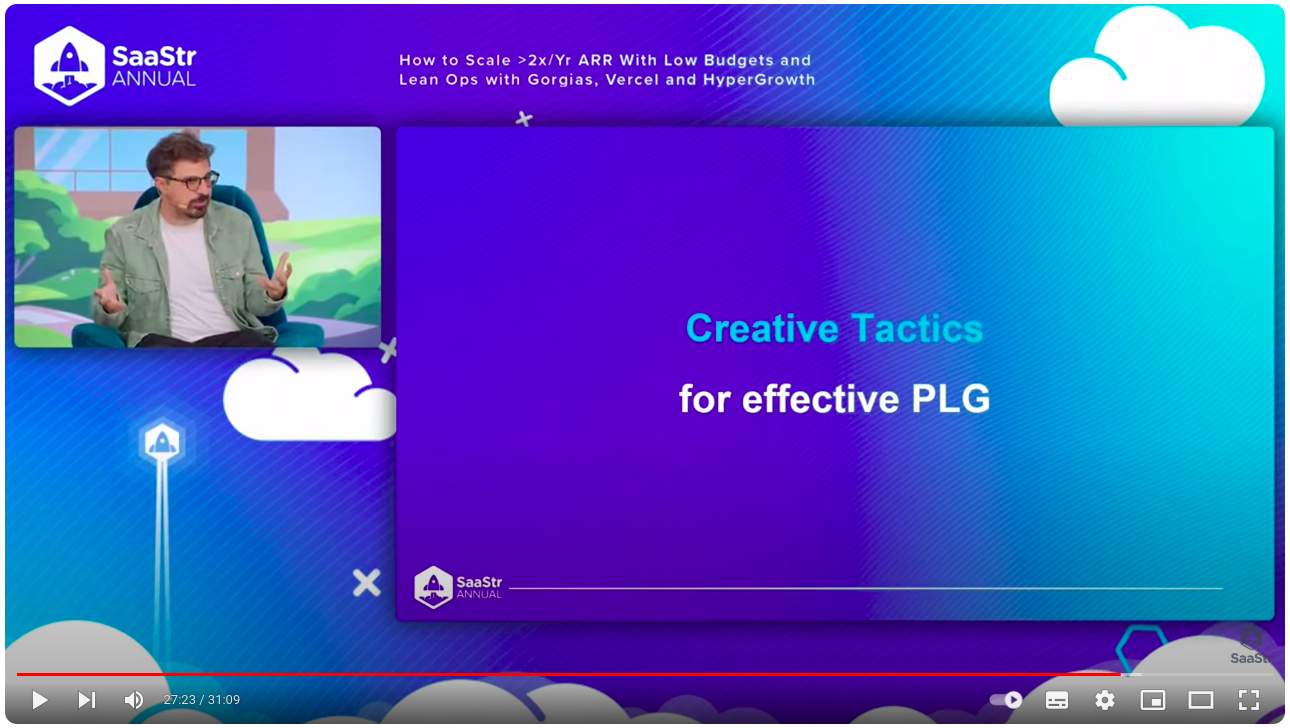
Gonto shared an interesting play that they tried at Auth0 when he was running growth there.
So the story goes like this:
I think that doing just the sponsorship for the retargeting pixel could work.
But when you add that branding consistency between the sponsored site and the product the CTR is better.
Interesting one for sure.

How to communicate the flexible part of your plan?
Many dev tools have 3 plans:
Especially the ones doing some flavor of product-led-sales or open-source go-to-market.
Now, the Team plan is often a self-served version.
And for many dev tools, this part is partially or entirely usage-based.
So how do you present it?
You can just have "+ what you use" and explain it in the big table below.
But if you have just one usage dimension then why not do it here?
Resend does it beautifully communicating right away that it starts at 20$ / month and grows with the amount of emails you send.
Very clear. Very nice.
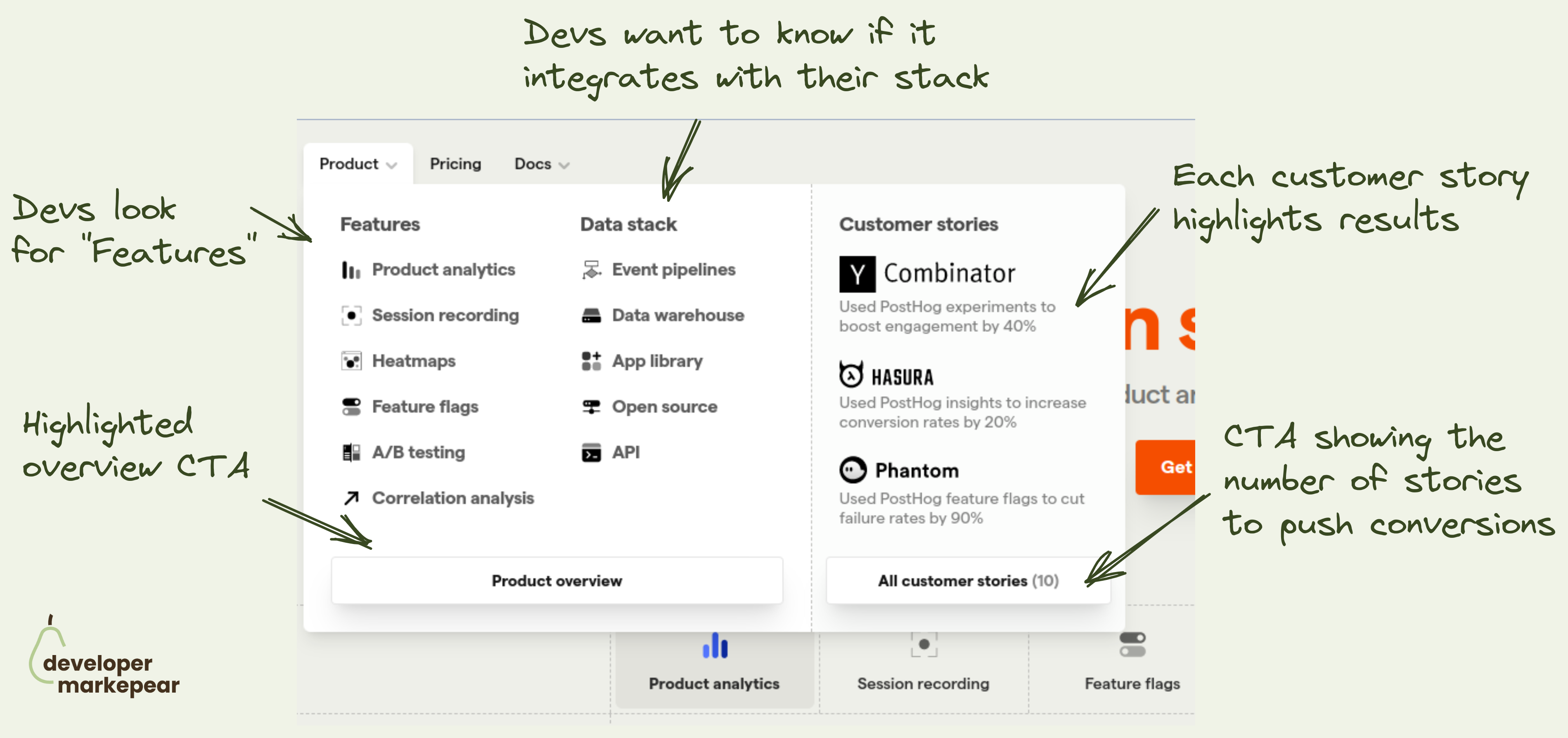
How to design the navbar product tab? This is what @PostHog does 👇
Figuring out what to put in the navbar is tricky:
The "Product" tab is especially tricky.
It can get overloaded with a ton of content.
I like how Posthog approached it:
I like it.

A great example of a dev-focused Linkedin post format from Khuyen Tran 👇
What I like about this:
Just great job!
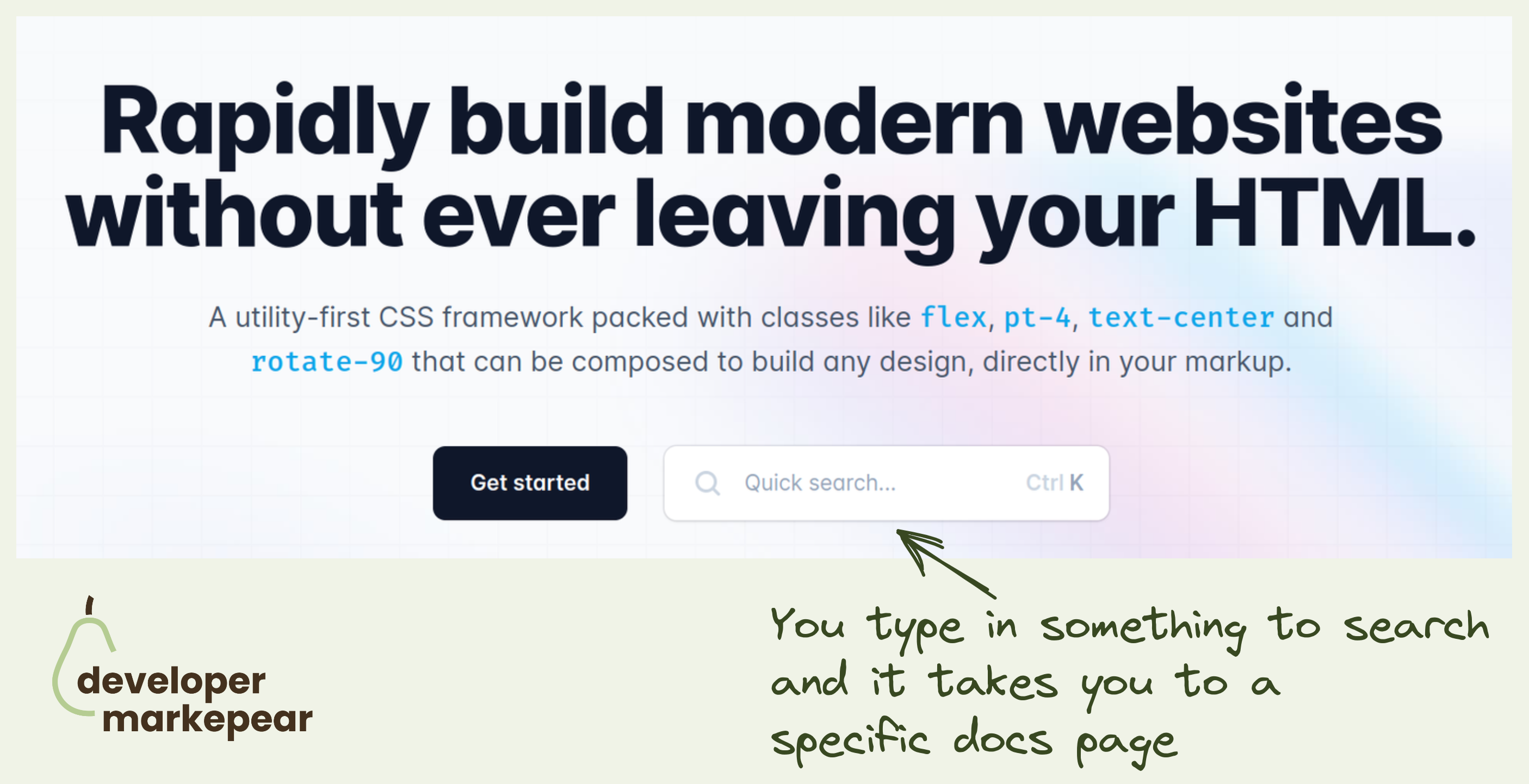
"See docs" is one of my favorite secondary CTA on dev-focused pages.
TailwindCSS takes it to the next level by inserting docs search right into the header CTA.
This takes devs directly to the page they are interested in rather than have them try and find things for themselves.
They could have searched the docs in the docs, of course.
But this is just this slightly more delightful developer experience that TailwindCSS is known for.

I like this idea of showing how your dev tool works.
With developers, you almost have to explain how it works on your homepage.
Many products do some version of Step 1 -> Step 2 -> Step 3 -> Success.
I really like how @SST approached it with a timeline.
I find it more engaging than those disconnected steps.
And when I follow this journey the final and logical step is to try it out. Get started.

In dev tools, you really can solve the problem for a narrow market and extend to adjacent markets over time.
Use that -> Snyk did.
Their value proposition stayed pretty much the same for 7 years!
"Find and fix vulnerabilities in open-source software you use."
But the market they served got so much bigger over time:
Again, their core value prop is the same in 2023 as it was in 2016.
But their target market (and revenue share) grew by... a lot ;)
Isn't that just beautiful marketing-wise?
So the takeaway is this:
Start narrow, solve the problem, and extend to other frameworks/languages/tech can still work.

Say what we are all thinking.
This tweet is great as it states something that most of us feel.
It is something that you may have had a discussion about with someone recently.
You might have fought about one tool or another.
But at the end of the day tools don't matter.
You can share it with someone as:

How to promote your important company event? How about right there in the header.
A typical approach to promoting events on your site is to have them in the Hello bar (right above the navbar). This is a solid option of course.
But what if this is a super duper important event that you really want to push?
Put it in the header.
The header is the most viewed part of the most visited page on your site.
Doesn't get much better than that.
But you don't want to distract people from your value propositions and main CTAs too much.
How do you do that?
This is how Vercel did with last year's NEXT.js conf.
Nice execution on that pattern.
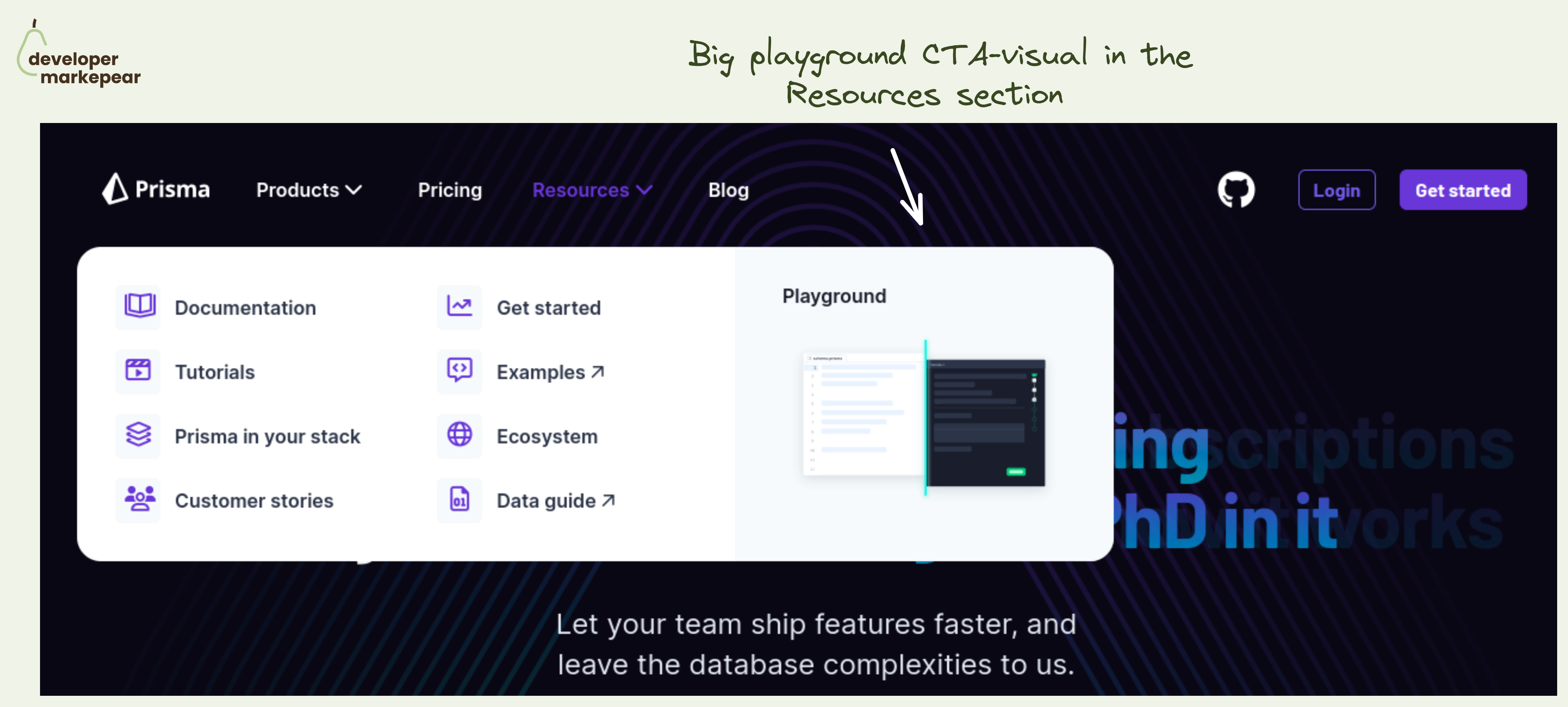
Simple yet powerful CTA in the navbar resources section.
The resources section in the navbar is mostly navigational. Well, the entire navbar is ;)
But you always have that one action that is more impactful than others.
💚 And I think that a Plauground is a great option. You get people to see how your product works. You let people play with it and see for themselves.
Not many next actions can be as impactful as getting people to experience the product.
Especially if you are a heavier infra tool that people cannot really test out in that first session. I mean, you won't really create a realistic example of your core database in 15 minutes to see how that new tool that you just saw works.
🔥 Making this CTA "big and shiny" and showing a glimpse of what will happen after clicking is great too.
🤔 2 changes I'd test out:
But the core idea behind making the playground your core navbar resource section CTA is just great.
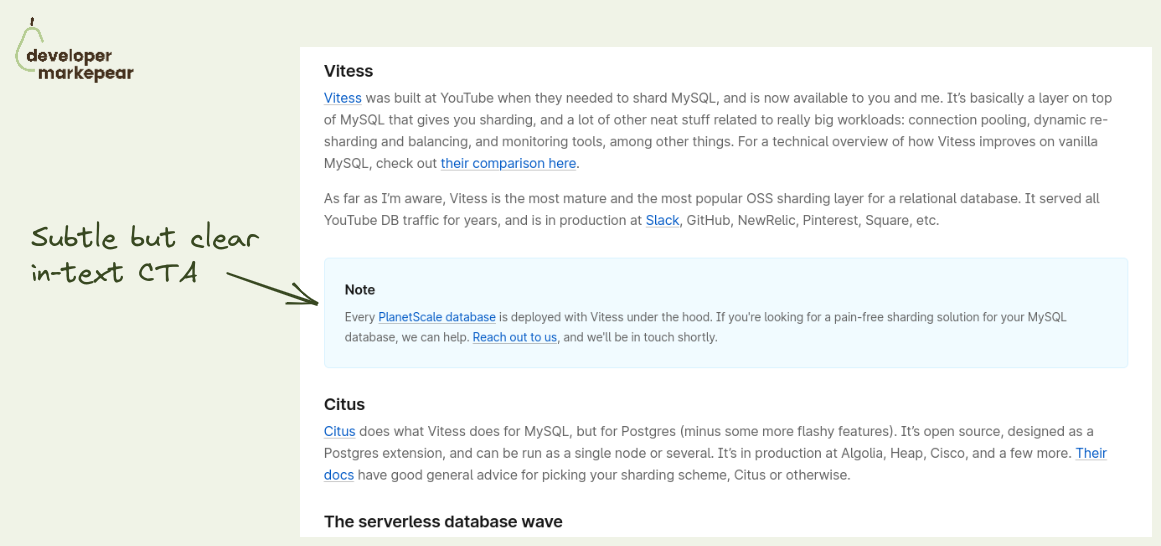
Subtle but effective dev blog CTA -> info box.
Basically a plain article in-text CTA but there is something special about it.
It looks like a docs info box.
It is not a "buy now" style call to action but rather a subtle "you may want to know about X" push.
But for it to really feel like an info box it needs to connect to the section of the section of the article around it.
Otherwise, it will just feel like an intrusive ad anyway.
PlanetScale does a great job here.
They link the part of the article about the sharding library Vitess with their product that was built on top of it.
It feels natural and I am sure it gets clicks and if not then product awareness.

In a mature category, it is safe to assume that people know about other tools.
Especially devs.
I love how Axiom owns its unique selling point and how it stands out from the competition.
Takes guts but I love it.
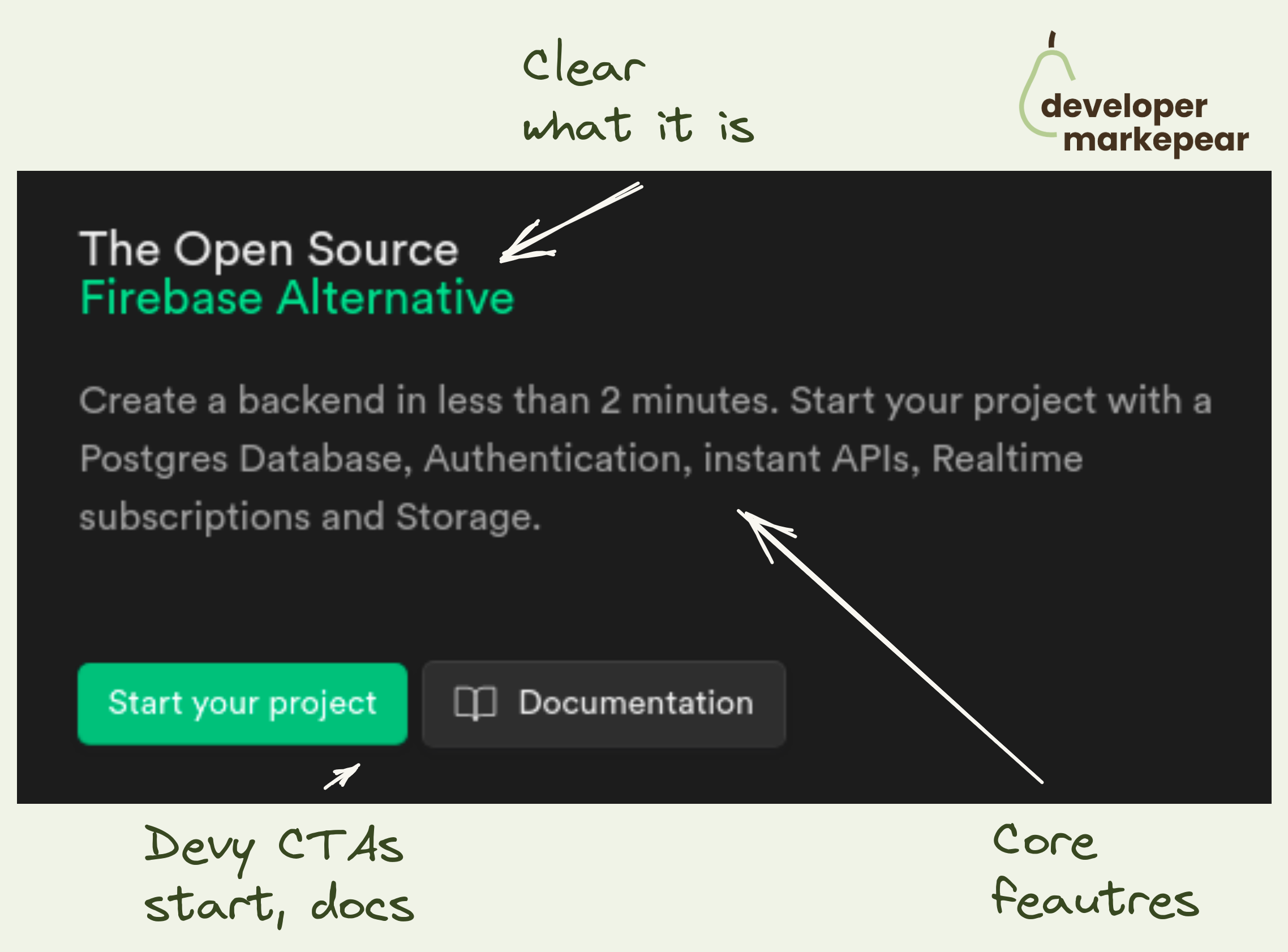
Say what you do and how you do it.
What:
How:
CTA (bonus):

I really love this hand-drawn feel.
It makes it super authentic.
Also, starting from scratch (not a ready diagram) makes following it more fun and less overwhelming.
Great stuff.
BTW the tool used for this is called excalidraw.com

Super short dev tool case study on a single viewport.
Many case studies follow a Hero -> Problem -> Solution -> Results framework.
Many try and do it on a one-pager.
But what @Resend did is next level and I like it.
Especially with devs, you want to be technical and succinct.
And Resend took all the possible fluff out of it.
I'd like to have some before or after probably or a stronger results (or pain) ) focused headline.
But I think this is great actually.

How to present benchmark results masterclass from RavenDB
The biggest problem with the software benchmarks that you run is?
People don't trust you. Especially when the results are good.
𝗬𝗼𝘂 𝗷𝘂𝘀𝘁 𝗻𝗲𝗲𝗱 𝘁𝗼 𝗯𝘂𝗶𝗹𝗱 𝘁𝗵𝗮𝘁 𝘁𝗿𝘂𝘀𝘁. 𝗢𝗻𝗲 𝗼𝗳 𝘁𝗵𝗲 𝘄𝗮𝘆𝘀 𝗶𝘀 𝘁𝗵𝗿𝗼𝘂𝗴𝗵 𝘁𝗿𝗮𝗻𝘀𝗽𝗮𝗿𝗲𝗻𝗰𝘆.
People from RavenDB do it by:
This looks solid because it feels like I could re-run what they did myself.And so I trust them and I probably won't ;)
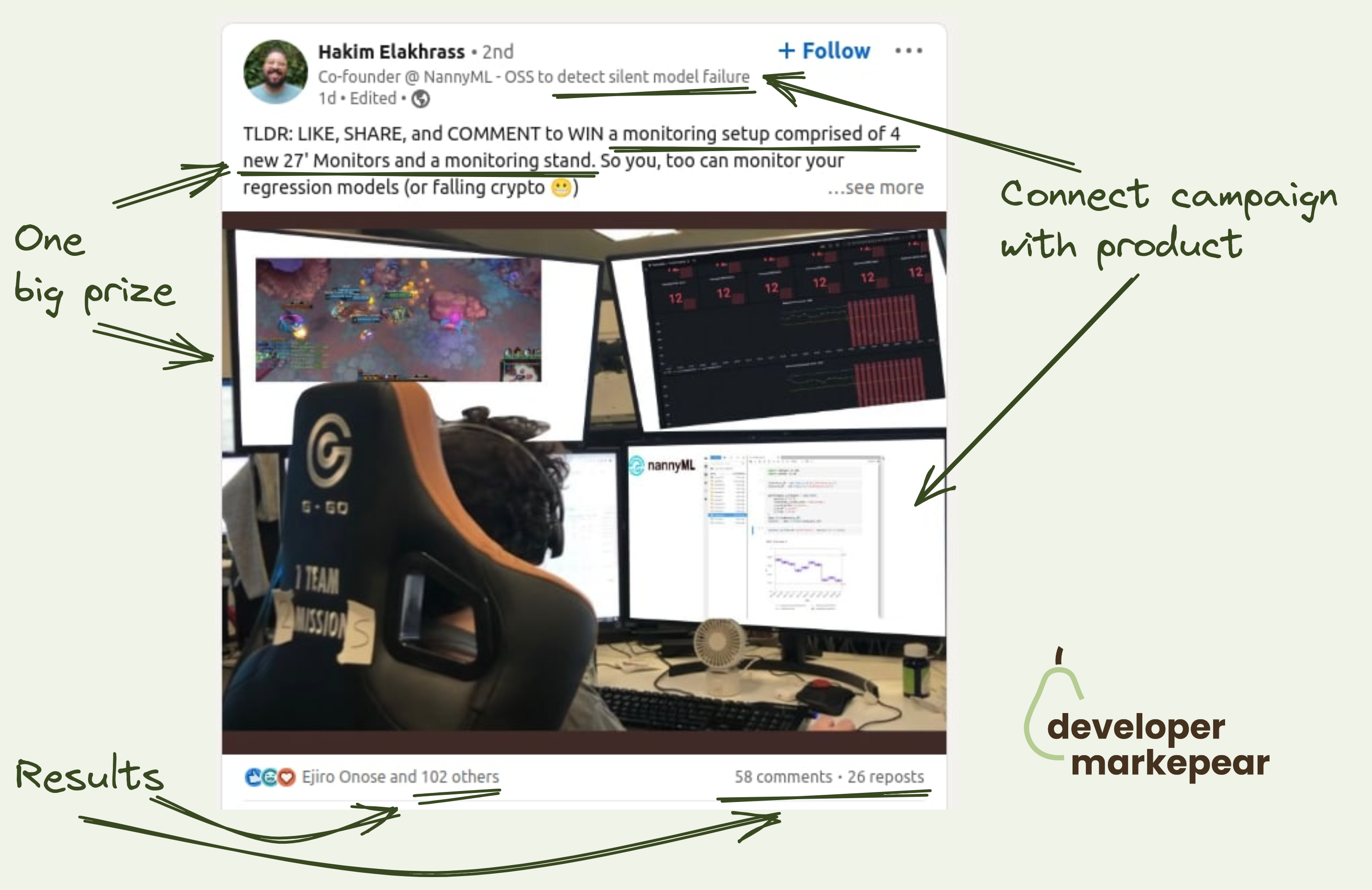
Is it better to do one big prize or many small prizes?
This is a decision you have to make when thinking about running a swag campaign.
Turns out that a small number of huge prizes can get you way better ROI on the same budget.
And NannyML has done it brilliantly here.
They are a monitoring tool and they give away monitoring setup.
This is something that actually can go viral. And it did.
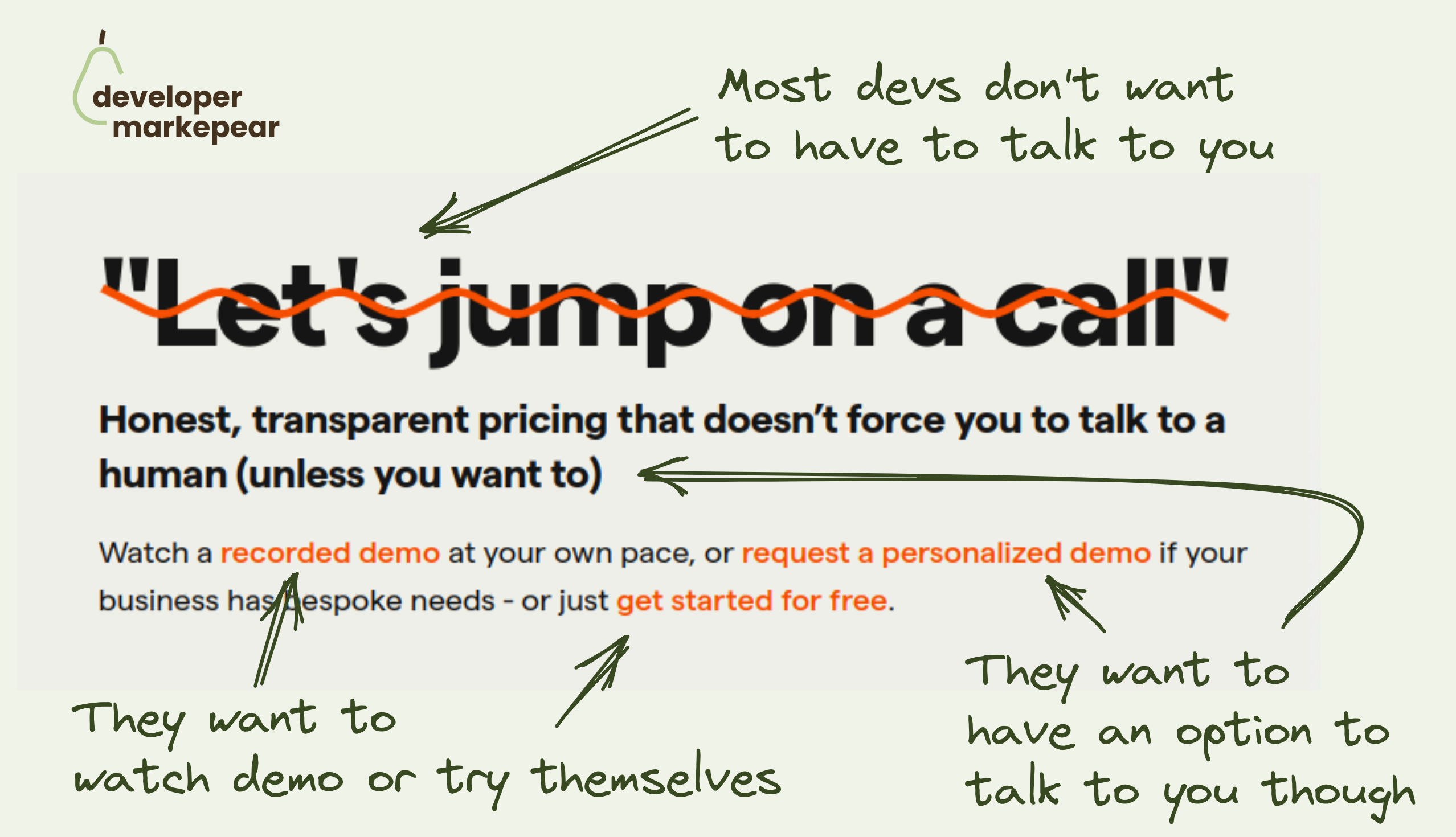
Most devs want to explore products themselves.
They want to read the docs, see examples, play with the product, or watch a video.
They don't want to hop on a demo call, especially early on in the evaluation process.
And they definitely don't want to sit through the demo to learn what your pricing is.
But there will be moments when they will want to talk to you. They will raise their hands and let you know then.
Posthog speaks to this reality with this copy beautifully:
This is very developer-focused approach and I love it.

I like how it has a proper "hero section" feel to it but it adds a developer-focused twist:
The rest of the Readme is great as well but the hero section is gold imho.

How did this super basic ad get so much engagement on Reddit?
First of all, the value prop is succinct, to the point, and says what it is.
No "streamlining", "boosting", or "democratizing" is involved.
No clever tagline or pains, benefits, or values just says what it is.
But what it is, is "free and open-source" which is what many devs, especially on Reddit want to hear.
And Heroku is a known brand so if you know what Heroku does, you know what Kubero does.
I liked that they linked out to the GitHub project too.
Not 100% sure if that would perform better than a landing page or home. But I see how it feels more in sync with the channel you are running your ads on.
The screenshot? I don't like it but perhaps it doesn't matter as much here?
What do you think?
Oh, and if you read the comments, you'll see that people actually talked about the project, said that they liked the ad etc.
Good stuff.
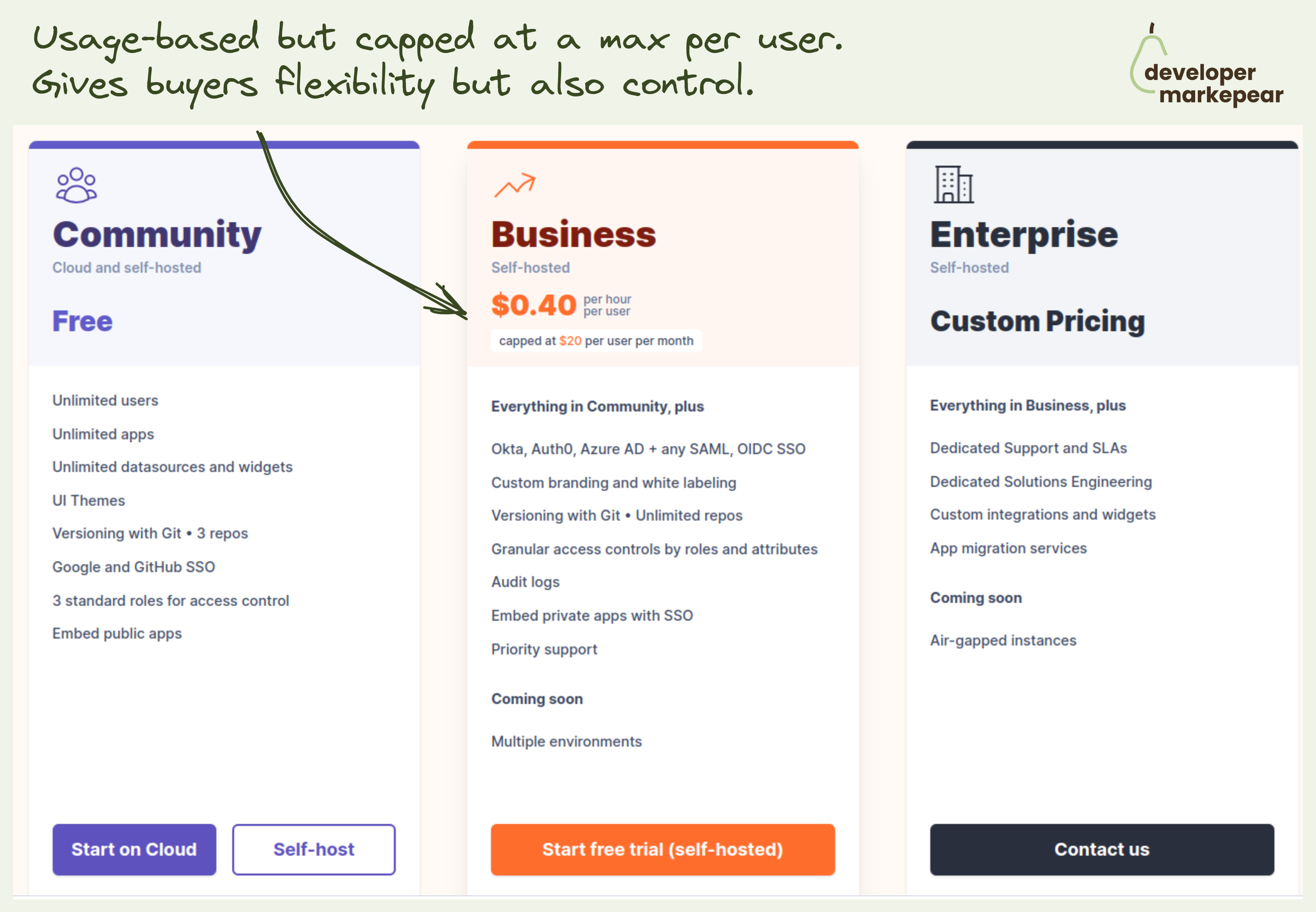
Usage-based pricing is loved by devs. But has its own problems.
Ok, so first what are those problems?
Value metric:
Predictability and procurement:
But devs love usage-based pricing:
It is great for a dev tool company:
But pulling it off is not as easy as you may think.
Choosing that value metric, packaging it, and presenting it is a struggle.
@Appsmith solved it in the following way:
Very interesting approach.

Developer-focused Reddit ad. 33 upvotes, 30 comments.
So @Zesty is a company that targets devops folks and helps with cloud cost optimization.
And they decided to run Reddit ads.
So they:
And they got 33 upvotes and 30 comments.
Some of the comments were technical.
One comment that got 67 upvotes was actually
"Okay, this ad is pretty funny"
And I agree, this is a pretty funny ad that I am sure brought them some brand awareness and clicks.

Beautiful mockery of classic conversion tactics from PostHog website.
So what do we have here:
I have to admit I chuckled ;)
And I bet many devs who don't think of marketing very highly chucked too.
That builds rapport. (hopefully) makes you one of the tribe rather than another faceless corpo.
BTW, they used it as a bottom of the homepage call to action.
I like it.
Most of the people who scrolled there are not going to buy anyway.
But they may share the website with someone who will.

When selling dev tools you typically have 3 "buyer" levels:
Individual dev:
Team lead:
Org lead:
How does Postman solve it?:
They even go the extra mile. Something I didn't see too often.
They understand their customer's reality and identified one more level between Org and Team.
Basically a department-level unit that probably has multiple teams but is not at the organization/enterprise level.
I really like what they did hear. Solid.

This is one of my favorite our dev tool vs competitor blog posts.
With these pages, you want to explain when you are better.
But you don't want to berate your competitor.
And above all, you want to help people make a decision.
Chances are (almost 100% ;)) that you are not better for every use case. And your developer audience knows it.
But there should be use cases, tool stacks, or situations when you are the best option.
Talk about those. Dev to dev.
@Convex did a great job in this post that I think can be a template for how to write these:
After reading that post you are fairly convinced that if your situation matches the one described and if it makes sense to use it.
Love it.

"How fast do you ship?"
Not many dev tools answer that on their homepage. PostHog does.
In a typical (enterprise) sales process, people often ask:
And you show them the roadmap or get someone from the product on the next call.
But I haven't yet seen dev tools talk about it on their homepage.
But why not?
Devs who want to buy self-serve want to know it almost just as much.
After all, they won't be able to twist your arm to build that custom feature cause "we are your biggest client and we need it".
I like it, it builds trust, it shows me you are transparent,
And it shows me that those features I can see on the public roadmap will come true.

How do you make your dev tool pricing simple?
I really like this one.
Saw someone share a pricing page from Userfront some time ago and really liked it. They changed it now but I really like the thinking behind the older version.
It is just remarkably simple while hitting all the boxes:
Just a very good baseline.

Dorky joke right?
But it does two very important things beautifully.
It gets a smirk (from some people) and when it does you know you just moved someone closer to your brand.
It has a clear CTA which is hard to do with joke-format ads.
This subtle call to conversation/check us out does the job.
Love it!

Just an awesome billboard/ad format for a dev too company coming from Vercel.
What I like about it is:
Simple and beautiful.
Btw, they actually run similar ads on Reddit and it makes a lot of sense IMHO.
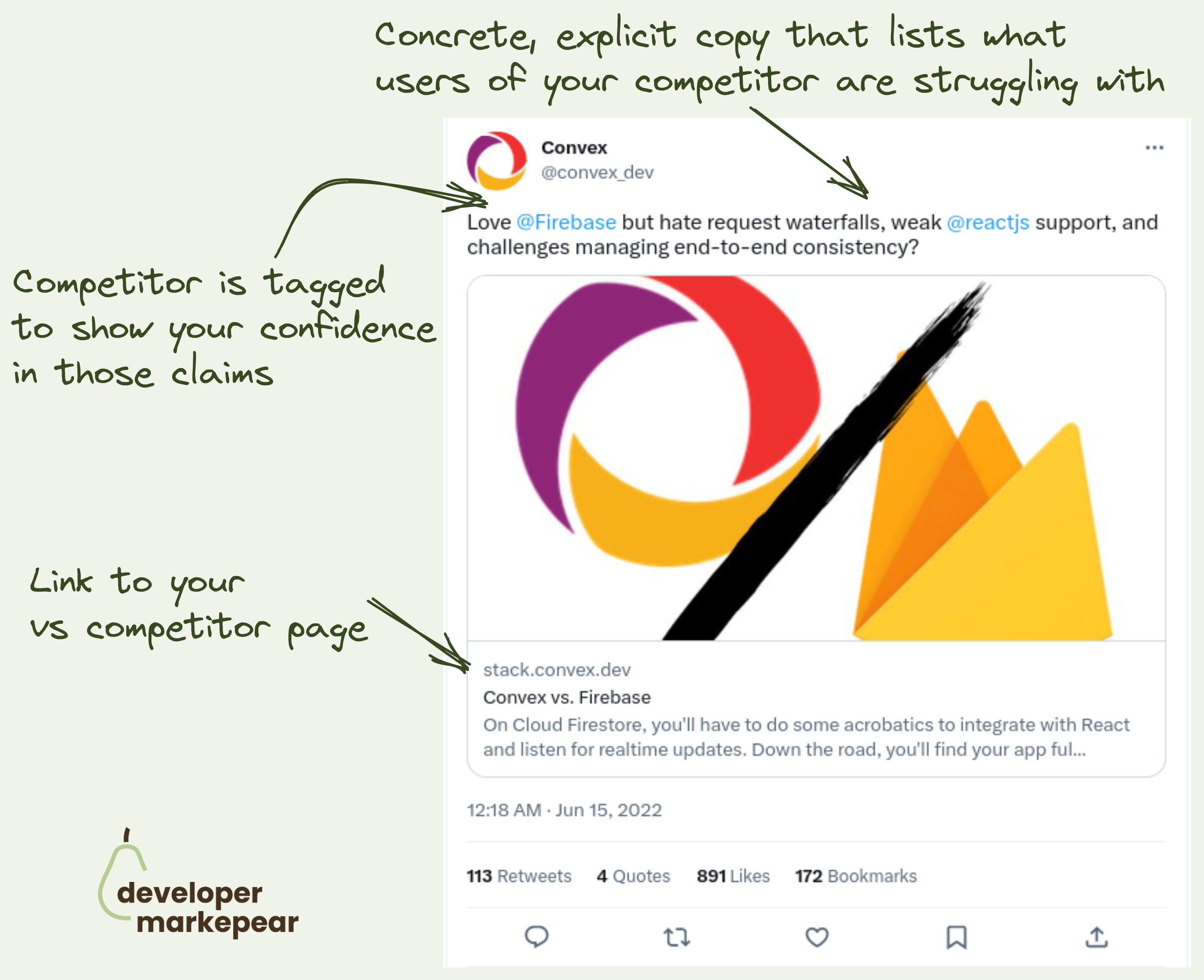
VS competitor ads are hard to pull off with devs. Not impossible though. 👇
So the problem is that:
@Convex does it really nicely here:
And even though this is by a "aggressive" competitor marketing hundreds of devs liked/bookmarked this tweet.
Good job!

A classic "It doesn't suck" campaign.
Afaik, Barebones ran the first version of this campaign 20 years ago and it was a huge success.
It is so simple, it just speaks to that inner skeptic.
It doesn't say we are the best, we revolutionize software.
It says it doesn't suck.
That is way more believable and makes me think that there is a dev on the other side of that copy.
And there is something cool about this message that makes me want to wear it to the next conference.
Good stuff.

Great above the fold
The subheader explains the value proposition.
Header handles major objections:
Then we have 3 CTAs but they are super focused on devs:
Then it goes on to explain how it works with a simple, static graphic.
This whole thing makes me feel peaceful.

Funniest dev tool explainer ever? Coming from Wasp.
Let's face it, introducing a problem in an explainer video is often boring. Especially if the problem is
How do you introduce a SaaS boilerplate? Good luck pitching faster time to value or something.
Wasp did something out of the box:
Got me hooked and kept me watching for sure.
+ funny is memorable so you will get a better recall too.

How to do a dev-focused brand video and get 10M+ views?
Making a memorable brand video is hard.
Doing that for a boring tech product is harder.
Doing that to the developer audience is next level.
Postman managed to create not one but three of those brand videos that got from 4M to 10M youtube views.
The videos I am talking about are:
So what did they do right?
Honestly, I am not exactly sure what special sauce they added but those are just great videos that you watch.
And I definitely remember them and the company which is exactly what you want to achieve with brand ads.

This is a really clever billboard campaign.
Show don't tell they say.
And Segment did exactly that by putting billboards with the wrong location printed on them (LA in SF etc).
The theme/message was "What good is bad data?" which was exactly what they wanted to convey.
What I like about is the alignment between:
This is hard to do imho so big kudos to them 🎉!
Downside?
Reportedly many folks who saw billboards didn't get that it was intentional and Tweeted at them about the error.
Or maybe they were next-level jokers...

Understand who is reading. Add social proof that speaks to them.
Social proof is about showing people/companies who are similar to the reader that they got success with the tool.
Company logos can be good if your reader knows and likes those companies.
But if those are random companies, I am not sure how much value does it bring.
Devs care what other devs who use your product have to say about it.
That's why I like testimonials.
Not the crafted, clean ones with features and values.
But the real stuff. Real devs sharing real stories.
Bonus points for "Okay, I get the point" button copy.
It changes from "Show more" when you click.
Nice!

This is a sandbox experience folks over at Sentry.io created.
I like the navbar CTAs with a big "Documentation" button in there.
Reminds me that I can go and see it when I need it.
But I also get those conversion focused "Request a demo" and "Start a trial" for when I am ready.
On top of that I get tours and help in the sidebar for when I get stuck.
.... and the whole thing is gated behind a work email which I don't love.
But having that work email let's you nurture (and Sentry is known for awesome emails).
Plus it does help sales. If anything it is an additional signal for your account scoring models.
But if you are going to gate a sandbox, make sure to show all that value behind the modal like Sentry did.
With that I can feel compelled to type in that email.

There are a lot of boring vendor t-shirts at conferences.
And they get boring results.
I like this bold design from GitGuardian:
Nice.